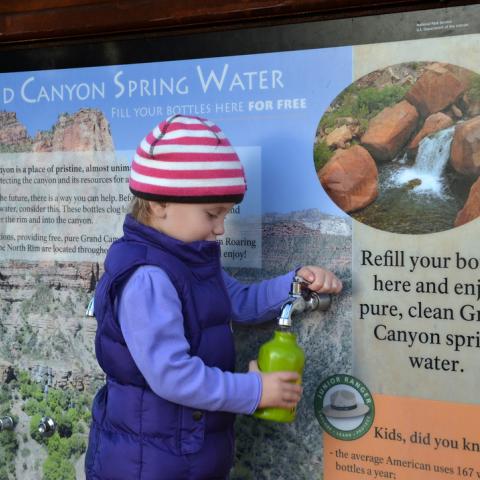
Arizona officials will be working with the National Park Service to cull bison from Grand Canyon National Park's North Rim/NPS
An agreement has been reached to allow the Arizona Game and Fish Commission to work with the National Park Service to cull the number of bison on the North Rim of Grand Canyon National Park.
In an effort to disrupt the "refuge effect" that allows the House Rock bison herd to grow where there is no pressure on them, the agreement includes a number of tools for herd reduction including live capture and translocations, hazing and lethal removal by skilled volunteers. Given the current distribution, abundance, density and the expected growth of this herd, the public and the Park Service are concerned about increased impacts on park resources such as water, vegetation, soils, archaeological sites and values such as visitor experience and wilderness character.
Reducing the herd size to below 200 bison will protect the ecosystem, park resources and values, according to a park release. The herd reduction activities are conducted under a 2017 Environmental Assessment conducted by NPS and supported by the State of Arizona and the US Forest Service.
Grand Canyon biologists, working with AZGFD staff, began piloting live capture and removal in 2019. In the two seasons of the program, 88 animals have been captured and relocated to five American Indian tribes through an agreement with the Inter-Tribal Buffalo Council. These animals will augment existing herds managed by these tribes. In addition, NPS biologists have placed GPS collars on 25 animals to help with population estimates, migration patterns, and temporal locations.
The agreement describes the process whereby staff from AZGFD and Grand Canyon National Park will work together on lethal removal protocols. The earliest that skilled volunteers could likely be utilized is fall 2021. The timing of and number of bison to be removed will be identified annually through an NPS operating plan. AZGFD will assist NPS with selection of qualified volunteers through a random selection process. Selected volunteers will go through additional vetting by NPS, including a background check and a firearms proficiency test. There will be no fee for applying or participating.
"Selected skilled volunteers will be able to take up to a single bison including head, hide and meat in exchange for removing the carcass from the field. The Game and Fish Department will provide the volunteer with the necessary permit to possess and transport the carcass from Grand Canyon National Park," said Arizona Game and Fish Commission Chairman Kurt Davis. "There will be no waste of game meat, and no waste of tax dollars to contract for paid sharpshooters."
Biologists estimated that the bison herd, which initially numbered about 100 when brought to the House Rock Wildlife Area in the early 1900s, had grown to between 400 and 600 bison by 2014. Though the bison roam the Kaibab Plateau, they spend most of their time on Grand Canyon's North Rim. It is estimated the herd could grow to nearly 800 in the next three years, and as high as 1,500 within the next 10 years, without further management actions to control the size of the herd.
"I am pleased with the working relationship we have developed with Arizona Game and Fish Department and the commitment of staff from both agencies. This agreement, and the management of the North Rim bison herd, is important to the greater goal of responsible management of park resources and bison conservation," said Grand Canyon Superintendent Ed Keable.




 Support Essential Coverage of Essential Places
Support Essential Coverage of Essential Places







Comments
I was wondering if these bison are indigenous to the area, but I see they were introduced like their fellows on Catalina Island.
I just love the expression "lethal removal." Why not send all the surplus bison to the various refuges and reservations that exist
in the bisons' native range?
Murray, these bison were the result of cross-breeding by Charles "Buffalo" Jones early in the 20th century. He wanted to create a hardier breed of "catalo" that could withstand blizzards yet be more docile than bison.
The culling operation on the North Rim is just part of the effort to reduce the number of these animals. They've already shipped some off to tribes.
https://www.nationalparkstraveler.org/2020/09/bison-grand-canyons-north-...
Was humane birth control considered? PZP?
Do you have to be an Arizona resident to be considered for the removal?
This is just heartbreaking. I feel that they want to do away with too many of them at once and I worry about disease or other natural disasters that can destroy the few remaining bison. What about inbreeding with such few remaining? I don't think this was a well thought out plan. Hopefully they can survive this as planned. My heart is very heavy with sorrow.
Most likely this won't happen, this has been a plan years in the making and I doubt the whole population will die just like that. More realistically a lot more Bison will die if we don't cull them as well as more other species as their resources will be wiped out with the influx of Bison in the area. Sometimes culling doesn't work, though most of the time it saves many species from overpopulation.
These are not genetically pure bison, such as those in Yellowstone. That limits where they can be transferred to so as not to breed with true bison.
No, you just have to be a heartless killer.